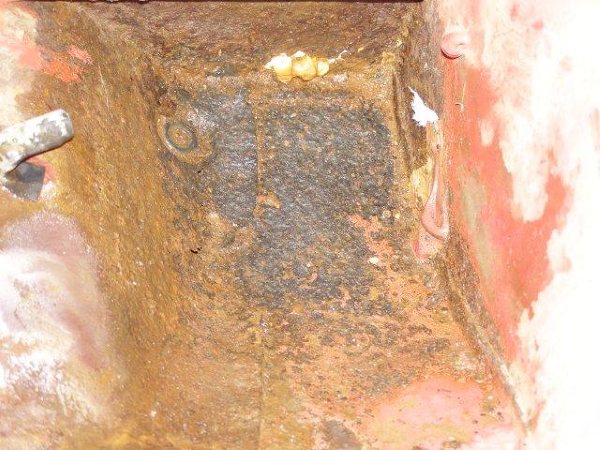Full Version: WhO's THE BEST
...I am really liking this...if you could be so kind to post a photo of the metal on the results of this, I would appreciate it...also would like to contact you, if I may for a little detail on the procedure...I have a spot on my car I'd like to try. The surface is convoluted and I would hate to have to cut and weld on it...
More pics to follow, putting it on for another cook. dlestep, I'll pm you my phone #
After cooking about 4 total hours. I have maybe 10 minutes actual work into this:

It's pitted to all get out and I'll have to address that, but that big blackish spot in the middle isn't rust

It's pitted to all get out and I'll have to address that, but that big blackish spot in the middle isn't rust
Actuallly, if you do it long enough, the black turns to slime that can be brushed off with a wire brush. I like the copper bristle brushes as they seem just about right. You need a lot more time with that sponge or you need to fill the drain hole, fill it with solution and float the positive electrode over that hell hole on a foam block.
With the big tanks, foam floats can float the positive anode over the part. Was able to clean my 48 inch mower deck that way by moving the float. Took about a week.
When you are done, the metal is bare and gray, and you can actually see the rust pits are conical. It's those conical pits that prevent sandblasted sand from getting all the way in to the root of the rust cell.
Want toxic? Add zinc to the mix. The factory used a gray primer that contained zinc and it takes a good while to get it softened up and off the parts.
The stainless holds up under the current and I have yet to eat much off of one. The lye eats the paint at a mix ratio of 1 Tbs per gallon.
And to make it go faster, I use a high power prototype electrosurgical generator.
Per the baking soda, rust removal slowed to a trickle.
Tried the spoge thing for years but it usually boils dry pretty quickly. Even tried a fish tank pump and a stainless tube as a spray device. Pumped the conductive solution out of a bucket, and into a rubber tube with a stainless tube at the end. Clipped positive to the tube, negative to the car and sprayed at the side of a car. Solution trickled down the car and back into the bucket. Didn't seem to work at all.
Ken
With the big tanks, foam floats can float the positive anode over the part. Was able to clean my 48 inch mower deck that way by moving the float. Took about a week.
When you are done, the metal is bare and gray, and you can actually see the rust pits are conical. It's those conical pits that prevent sandblasted sand from getting all the way in to the root of the rust cell.
Want toxic? Add zinc to the mix. The factory used a gray primer that contained zinc and it takes a good while to get it softened up and off the parts.
The stainless holds up under the current and I have yet to eat much off of one. The lye eats the paint at a mix ratio of 1 Tbs per gallon.
And to make it go faster, I use a high power prototype electrosurgical generator.
Per the baking soda, rust removal slowed to a trickle.
Tried the spoge thing for years but it usually boils dry pretty quickly. Even tried a fish tank pump and a stainless tube as a spray device. Pumped the conductive solution out of a bucket, and into a rubber tube with a stainless tube at the end. Clipped positive to the tube, negative to the car and sprayed at the side of a car. Solution trickled down the car and back into the bucket. Didn't seem to work at all.
Ken
I'm in good shape. I went with a bigger anode shaped more to the surface. I had a piece of 16 gauge sheet laying around and a sawsall. I was having so much damned fun I couldn't help myself. Shaped it to the metal with issues and drilled a bunch of holes in it. This time, I used about 5 layers of paper towels instead of a sponge. Closer contact means more reaction, but it also means you need to wet it more often. The holes helped in surface area and a path for more electrolyte to flow when things started getting dry. Had to wet it about every 4 minutes, but it was a damned site better that sitting behind an angle grinder for a few hours.
I just started watching the "charge" gauge on the charger. When it started getting close to 100% charged, it's time for another bath.
BTW, don't use a rock as an anchor. That was probably a bad idea. The bottom of the rock is all pitted and there's a bunch of green stuff in the mix now. Probably copper
I just started watching the "charge" gauge on the charger. When it started getting close to 100% charged, it's time for another bath.
BTW, don't use a rock as an anchor. That was probably a bad idea. The bottom of the rock is all pitted and there's a bunch of green stuff in the mix now. Probably copper
This is a "lo-fi" version of our main content. To view the full version with more information, formatting and images, please click here.